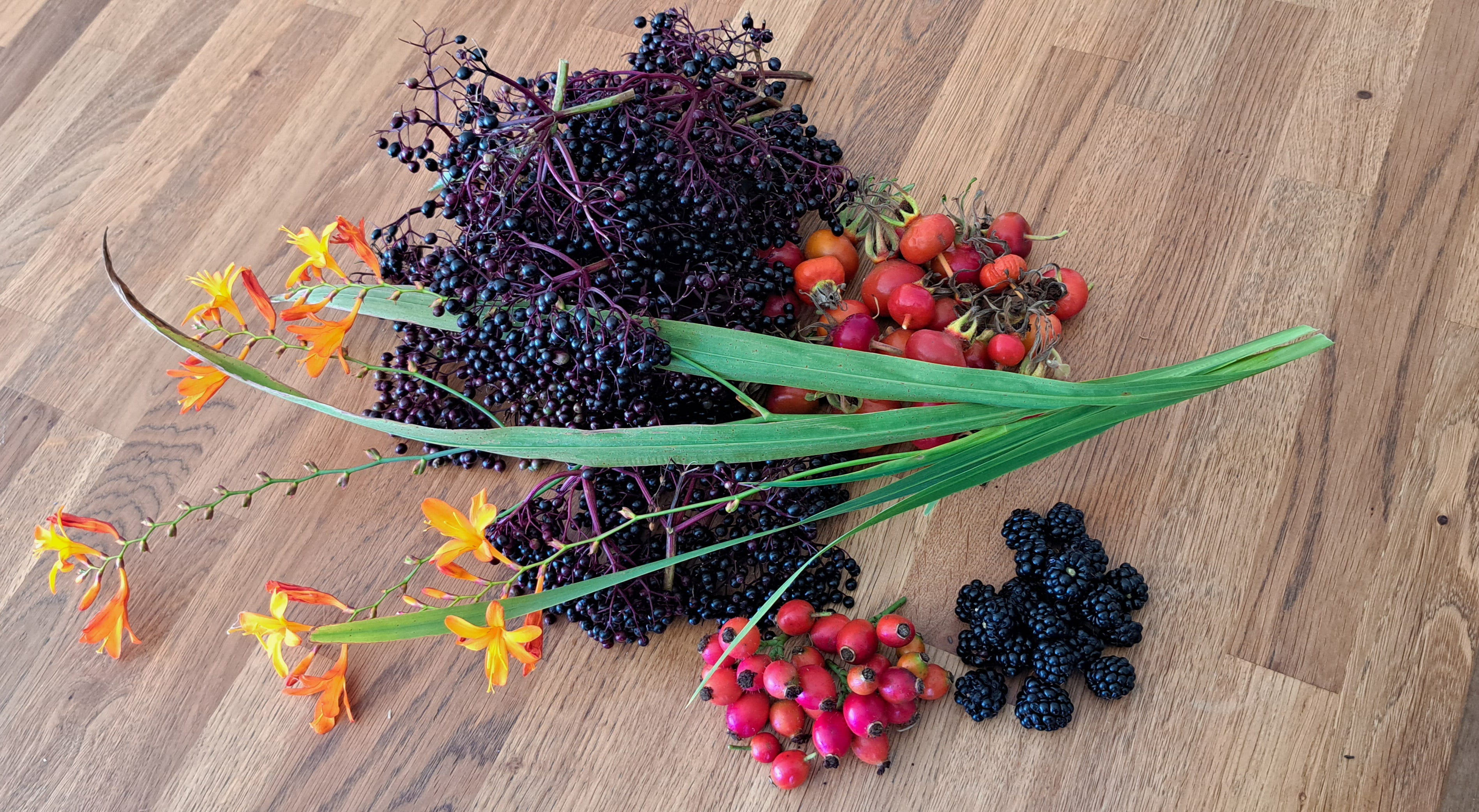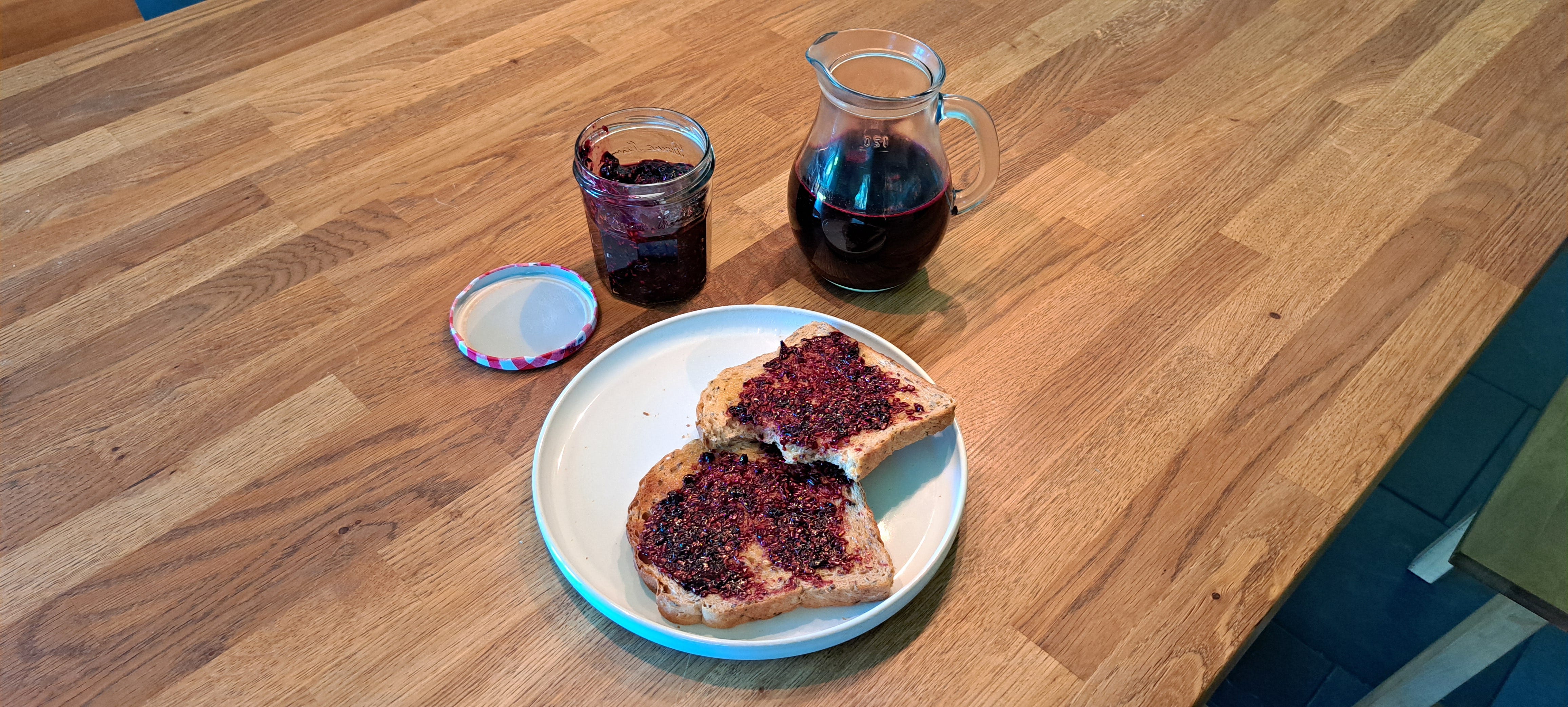Plant Generosity & Negative Reciprocity
and how to make delicious health-boosting Elderberry syrup
Céad míle fáilte, a hundred thousand welcomes to H A G! I’m Ali Isaac, author, mother, historian and guide. My book, Imperfect Bodies, will be published by Héloïse Press in the spring of 2026.
Berry Confusion
The first time I encountered elderberry, I didn’t know what it was. I was mooching around the old abandoned site of Fore Abbey, when I almost stepped on a cluster of tiny purple-black berries held on a spray of deep red stalks. I picked it up, puzzled, and laid it on top of a stone wall where it glistened in the sun, oozing juice. I was fascinated. I left it for the birds. The following spring, I noticed sprays of tiny white flowers in the hedges, held together in masses as big and flat as plates. I didn’t connect the two. I remember trying to describe them over the phone to Jenni, who knew about these things, but my incoherent description just puzzled her, and we were both stumped. Now, many years later, I know that they are parts of the same plant - Elder.

Human Interaction
In early September, there was abundance in the hedges. Every walk brought me gifts from nature: flowers to decorate my home, fruits and nuts and leaves to be eaten. I must admit, I became a little complacent. I went on holiday, and when I came back two weeks later, everything was gone.
Fair enough if it was left to the wild things that rely on it, or shared with fellow foragers. But that was not what happened. The elder trees had been cut back prematurely into stumps by an overzealous landowner. And the stretch of path where once I had gathered wild raspberries and horse-chestnuts had their verges completely removed and replaced with a wide ugly stretch of tarmac, big as a car park.
A farmer’s tractor has to access his fields, I know, and nature is resilient. But I can’t stop thinking of all that bounty/ beauty destroyed, all the little animals and bugs that found shelter and sustenance in the low tangle of undergrowth beneath those hedges now homeless, or probably dead. A small pocket of natural wilderness, a perfect mini eco-system surviving and thriving in a world that is ever more needful of it, wiped out. And yes, I am grieving.
Earlier in the year, I saved seeds from some of the wild plants growing in these hedges. I wish now that I had saved more, that I had gathered more elderberries and and conkers and stuck them in my freezer for processing later. I know now that walking the hedges, appreciating them and learning from them is not enough. If they go the way everything else is going, they too might soon be gone.
My house is situated on almost an acre of land. It’s not much, but I have given most of it back to nature. I have planted hedges, woodland, and bankings with native plants, and I let the grass grow and the leaves lie. My house sits on a hilltop, half of which was scaped away to make space for it, long before we came to live here. That means all the top soil, the natural seedbank, was removed in the process. I’ve waited patiently, and the wild plants are cautiously, slowly returning. But I think they need a bigger welcome, a helping hand.
Negative Reciprocity
In her book, Braiding Sweetgrass, Robin Wall Kimmerer writes about the importance of reciprocity, about how animal and human and plant have evolved on the land together, how their places in the ecosystem are interconnected, how balance and all our wellbeing rests on our interactions. Human activity in the landscape can be destructive and thoughtless, but it can also be positive and beneficial. She describes how the sweetgrass thrives on the interaction of humankind rather than being left to itself; the harvesting of sweetgrass thins the plants, giving them more space for receiving air and light, less competition for nutrients, less opportunity for disease to spread. The land needs human and sweetgrass, and human and sweetgrass need each other.
This is reciprocity, how we all benefit from giving and receiving. If it is too much one-sided, the balance is lost, and we move into negative reciprocity.
And this is where we are now. In negative reciprocity. Humans have plundered the earth’s resources to the point of ecosystem collapse. And still keep on doing it. And no COP meeting, no geopolitical agreement, no government or law holds these humans to account.
Faithful to the Land
A couple of weeks ago, I stood in the pitch black of the Morrigan’s cave, and thought of all the atrocities going on around me in and to the world. I wanted to stop feeling helpless, hopeless. I wanted to do some small thing to help in some way. I asked the universe, the Morrigan, anyone who was listening, what could I do, and I recieved a clear message: be faithful to the land. It was not what I expected to hear. I didn’t know then what it meant, or how ‘being faithful to the land’ could possibly help, but now I’m starting to.
It starts right here with this patch of land where I live. I have never felt I own this land, even though it says so on the deeds. I co-habit here, and now this land needs more direct intervention from me. I know who my wild plant neighbours are, but this year in particular they have been at the mercy of local landowners; I can’t rely on their presence as a given. I need to offer them space and shelter right here, where no human will harm them. It’s time to bring them home. I can’t stop farmers from the massacre of their hedges or poluting their land with fertilizers, but I can take care of my own patch.
Faithful means ‘to be loyal and steadfast’. That I can do.

How to make delicious health-boosting elderberry syrup and why you should
Going out for a walk to forage for elderberries is fun, good exercise, and your berries are free.
Elderberry syrup is so quick, easy and rewarding to make.
Elderberries are bursting with health- and immune-boosting properties.
Whipping up a batch of elderberry syrup in the autumn will see you and your family through a winter of coughs and colds.
It’s a natural, eco-friendly medicine that you know contains no sugar and none of the nasty chemical additives and preservatives that pollute so many modern foodstuffs, because you made it yourself.
Recipe and Method
First, gather your elderberries. Remove them from the stalks using a fork to ‘comb’ through them. If they are ripe, the tiny berries will easily pop off the stem. Dispose of the stems, as they are toxic, and don’t be tempted to eat any of those shiny purple berries raw, either. They need to be cooked to be edible.
Add the berries to a pan and cover with water. When boiling, turn the heat down and allow to simmer gently for about 15 to 30 minutes, until the berries have softened. You can mash them lightly to release the juice. When the liquid has reduced a little into a nice syrupy texture, turn off the heat and let cool for a few minutes.
While still warm, strain the liquid and berries through a muslin or nut milk bag into a jug, squeezing the cloth to extract as much of the liquid as possible. Be careful, as any splashes might stain.
Now add your local raw honey to taste (I only add 2 tablespoons and that is sweet enough for me), and stir until the honey has dissolved. Allow your elderberry syrup to cool completely before pouring into bottles. Keep in the fridge, or freeze. That’s all there is to it, and no tooth-rotting sugar or nasty preservatives.
NB. Most recipes require large amounts of sugar, but this is totally unneccessary and doesn’t affect the syrup’s texture. Also, most recipes will tell you to discard or compost the berry pulp after straining, but don’t do this! You can add it to your apple pie or crumble, make a cake or cheesecake with it, or turn it into jam, which is what I did, and it was delicious.
An adult can take up to 15mls of elderberry syrup up to 4 times a day.
Benefits of Elderberry Syrup
Effective treatment for colds and flu.
Can be taken daily as a preventative, or at the onset of illness to reduce its duration.
Contains phenols and flavenols which can help to reduce oxidative stress in the body that can lead to diseases such as type 2 diabetes and cancer.
Rich in Vitamin C and fibre.
Supports the immune system by helping to increase the supply of white blood cells.
Rich in anthocyanins, an antioxidant compound that gives the berry its colour and provides a powerful anti-inflammatory effect.
NB. All parts of the elder plant, except for the flowers, are toxic if eaten raw. Please only consume after cooking.
To find out more about the health benefits of elderberry, check the reference section below. 1
Tell me, have you ever made elderberry syrup? What home-made natural remedies do you swear by? Would you like to know what other natural products I regularly make and use?
Wishing you abundant health and good cheer throughout this dark half of the year. Grá Mór,





Wonderful words and thoughts as ever, Ali. Thank you 🙏 I too have been asking how I can make a difference, staying still long enough to hear the whispers. I don't have land and the words that keep coming to me day and night are "start in the corner you find yourself"... real change happens at the grassroots level I believe, the ripples moving out into the world. We can only start where we are with hope. Loved your words this morning, so very grateful for them and for your beautiful heart. Together we can x
I make elderberry juice and either make syrup or, this year, I used it in eldeberry kombucha! I'm lucky to live in Vermont where we have wild blackberries and elderberries, also apple trees gone wild. I was just talking today about how we need to live with our black bear neighbors - there's a mama and two cubs living in the woods - and as humans it's our responsibility to contain our smelly attractants to limit the bear visits. They were here first!